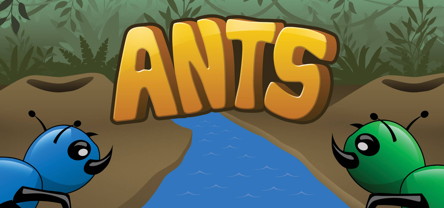|
It was a bright sunny day and we decided to visit Rotorua today. Rotorua is known for its
geothermal areas (geysers, hot springs, etc.). After breakfast we drove to Hamilton, about
a one and a half hour drive from Auckland. We drove past rolling green hills, and not much else.
We flipped through the radio stations (I'd forgotten to bring the CD's we bought the previous day),
finally settling on ZDFM (98.6). On the way home, we listened to the same station, which actually
has a "love songs 'til midnight" show.
There are lots of fast food restaurants in Hamilton -- Burger King, McDonald's, and KFC
were all there. We stopped in a McDonald's for lunch. One thing we noticed was that most of the
kids (even up through teenagers) were not wearing shoes or even socks. Is there some rule that
you have to go barefoot until you reach 18 in New Zealand? The adults all wore shoes.
It was about another hour and 15 minutes to reach Rotorua. With the stop for lunch (and
a couple other stops), we didn't get in to Rotorua until almost 2pm. The first thing we noticed
when we reached Rotorua was the smell! If you've ever been to Lassen or any other geothermal area,
you probably know the smell. We stopped in at the visitor's
center (there are prominent road signs to direct you there) to get some information. Some of the
attractions at Rotorua include Agrodome (sheep show), many places to see geothermal activity, the
lake itself, and Maori performances and dinners.
We decided to visit the Maori Arts & Crafts Institute. The Maori are the Polynesians who arrived on New Zealand before the European settlers. There
were wars and treaties and it's an interesting story which I won't detail. I did notice that there are
many Maori place names (such as Rotorua), and there are many signs with both English and Maori words.
For example, all Department of Conservation signs also say "Te Papa Atawhai."
We arrived just before one of the regular guided tours, which gave us a few minutes to
first browse the gift shop. Among other stuff, they sell bone and greenstone necklaces. They're
very popular in gift shops and arts and crafts stores throughout New Zealand. The greenstone
is called pounamu in Maori; you'll probably think of it as jade. Here's an interesting web
resource on greenstone, pounamu, and jade:
http://www.atonz.com/new_zealand/greenstone.html.
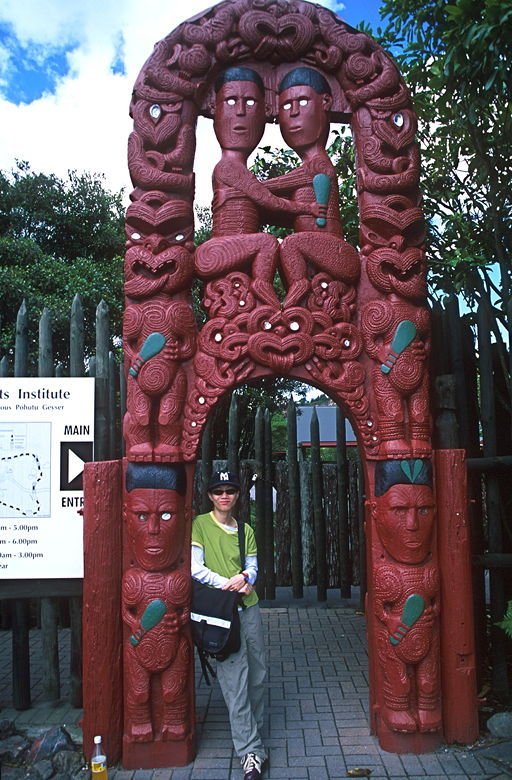
Entrance to Maori Arts & Crafts Institute
The guided tour turned out to be much too crowded, with 30 or 40 visitors and one guide. So
we decided to go off on our own. We visited the wood carving school. They carve wood like totem poles, but
more human-like. The hands are often carved to be set on a large tummy. We continued on to a large canoe
set on a small pond. If I recall, the canoe seats about 75 warriors and is about 20 meters long. After the
canoe we went next door to the weaving house. Two women were there, weaving. They happily agreed to be
photographed.
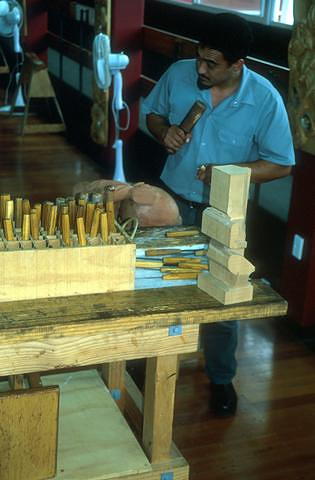
Maori wood carver
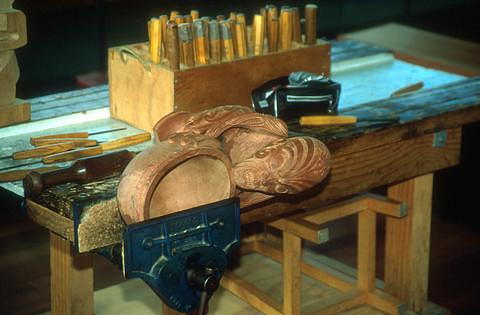
Wood carving in progress
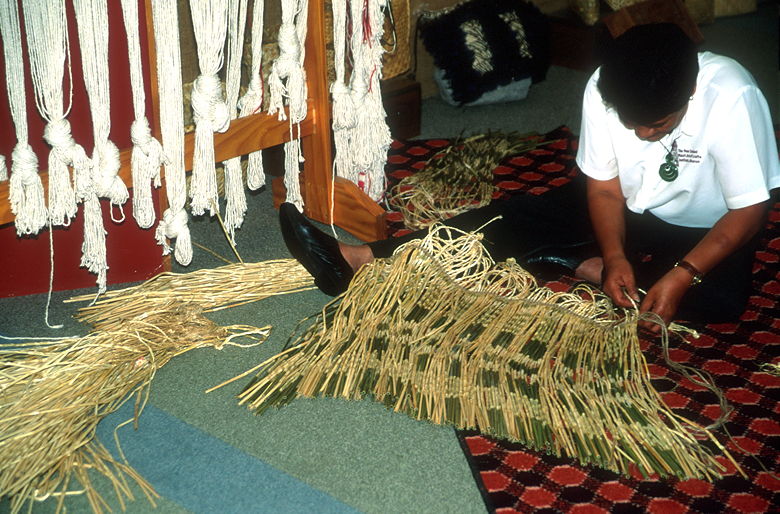
Weaving studio
We now left the buildings and walked onto the trails through the geothermal areas. We explored
boiling mud pools and geysers, some of which smelled worse than others. There are some places along the
walk with some nice views, but the smell makes it a bit hard to enjoy. As we approached the largest
geyser, the Pohutu Geyser, the wind carried the mist all the way to where we stood, at least 50 yards
away. I turned away to protect my camera and waited for the wind to shift. One interesting point: there's
actually a hotel right behind a large boiling mud pool. I can only imagine the smell from the balcony!
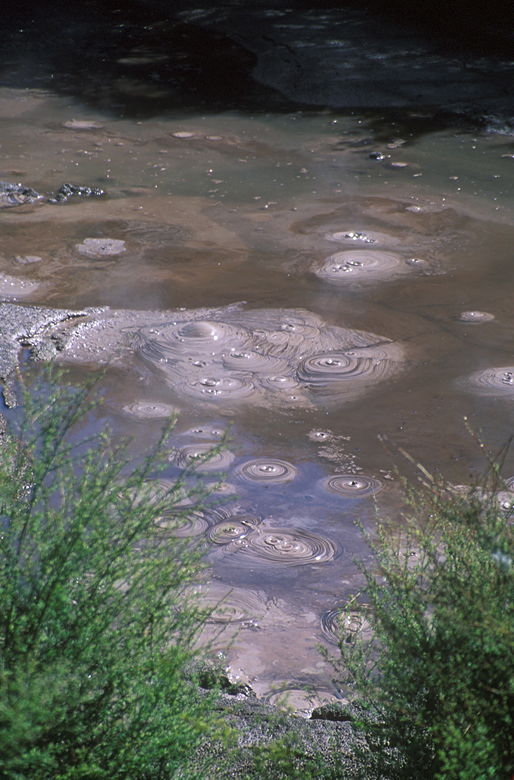
Boiling mud pool

Smoking pit

Pohutu Geyser
There's a kiwi house, which houses the nocturnal bird. It was dark inside and we were
instructed to be silent as we walked inside, so as not to disturb them. We did see one walking slowly in
the dark, but of course I can't show you a picture.
When we walked back to the buildings, we noticed a performance on the lawn. It's a welcome
ceremony called the Powhiri. It was being performed for one of the busloads of tour groups which comes
through, but we were welcome to watch from the gate; we'd witness the same for ourselves later. We'd signed
up for the performance and dinner later that night. We had a bit of time to kill now, so we drove back
into the city and visited a grocery store. Jean began her persistent search for wine gums; she found they
sold them in bulk at this store! I resisted the temptation to buy Tim Tams, which we'd originally seen in
Australia.
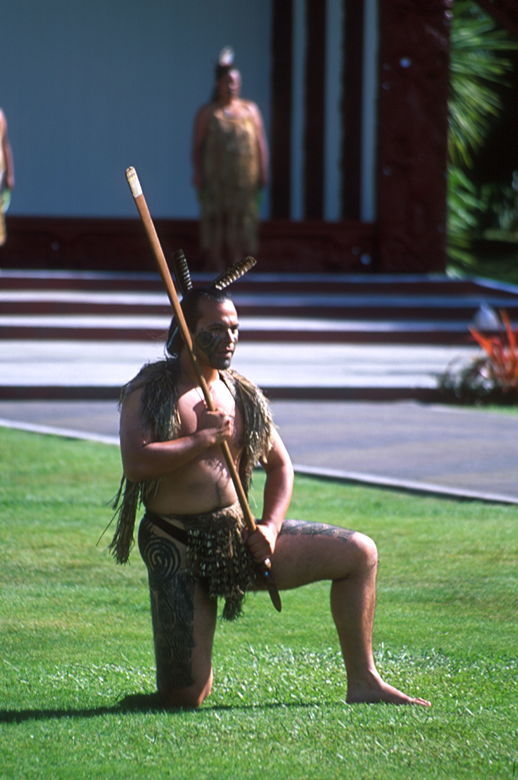
Maori warrior
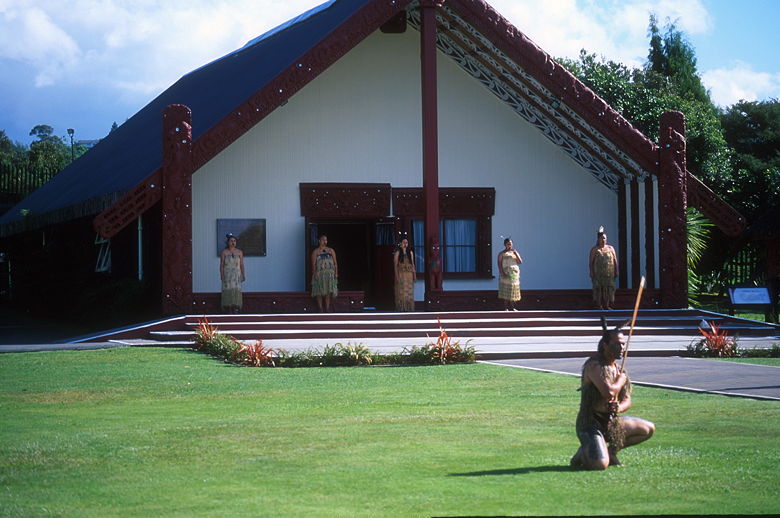
Maori house
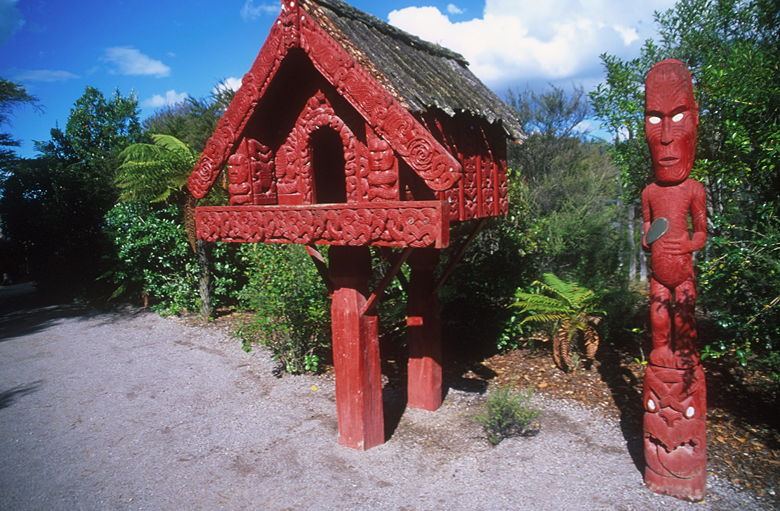
Hut and carving from the village recreation
We drove back to the Arts & Crafts Institute late in the afternoon to witness our Powhiri. Two
people were picked from the group of us (about 50 or 60 of us) to be our chiefs in the ceremony. The
ceremony began with 3 men taking turns yelling and twirling their weapons as they advanced on us. Then the
third man placed a leaf on the ground which was accepted by one of our chiefs. I'm not sure of all the timing
anymore, but the same was done for the second chief. The women Maori then called to welcome us into the
meeting house. We took off our shoes and went inside, where there were Maori speeches.
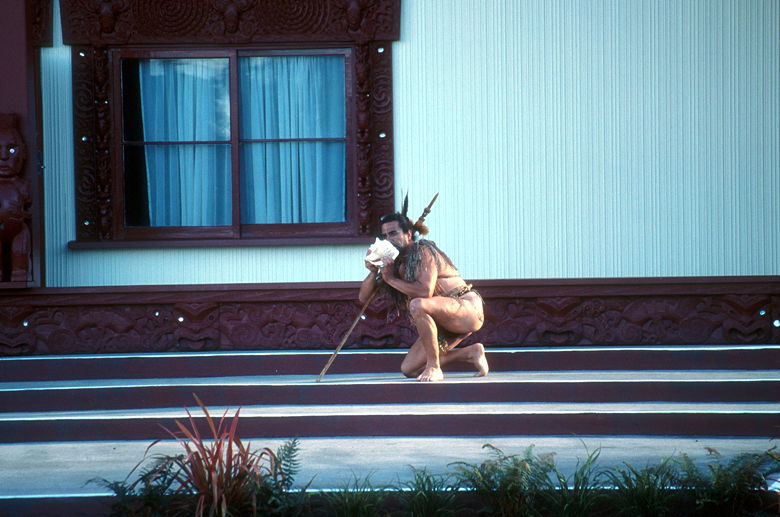
Blowing the conch shell
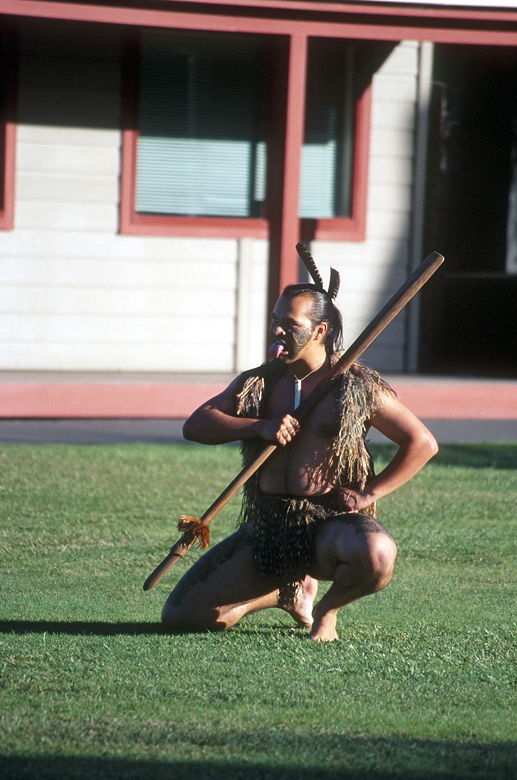
Maori warrior

Painted rear of a Maori warrior

Maori warrior with club

Maori warrior with club
Finally, the head Maori ended the formalities and welcomed us to sit back and relax (or even
come forward and sit on the floor, as we did), and enjoy the show. And we did enjoy it. There was
singing, dancing, and music -- including the Maori's favorite instrument, the guitar. They performed with
a ball attached to a string, rhythmically bouncing it from shoulder to arm. They performed with club weapons.
They performed with sticks, throwing them to each other like juggling performers on the street. They
also demonstrated hakka faces -- the hakka is used to intimidate an enemy; the faces used generally involve
sticking the tongue out as much as possible while making some intimidating sound. It is often performed
before rugby matches.
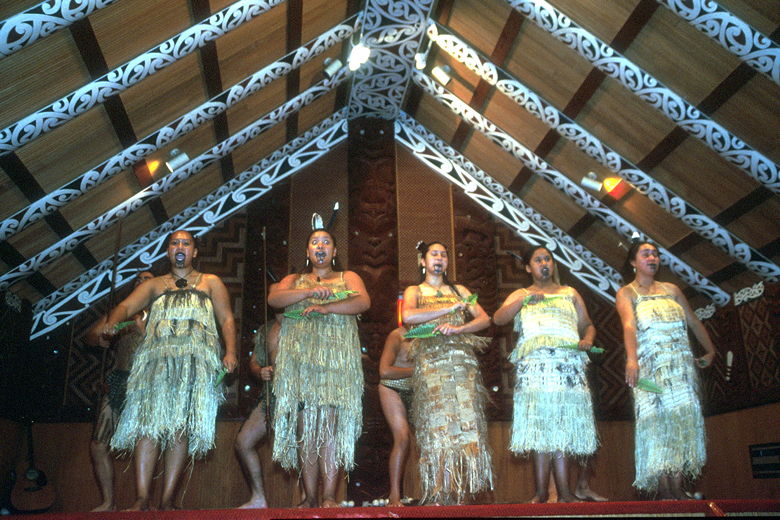
Maori women dancing
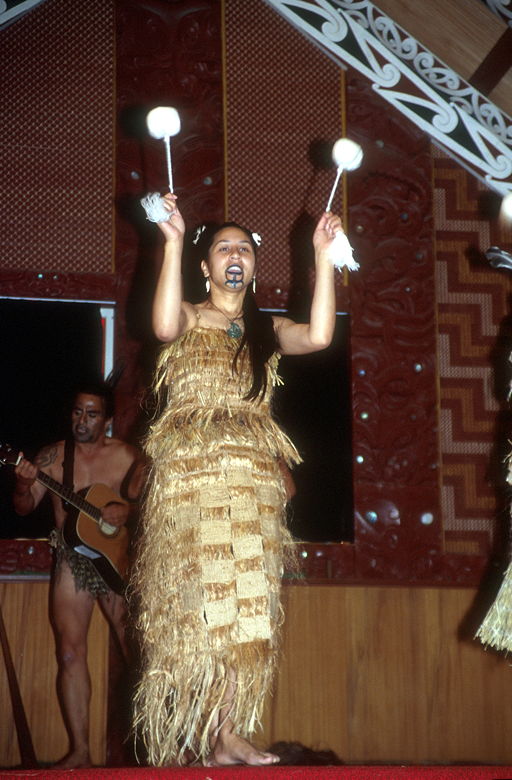
Maori woman performing with ball and string
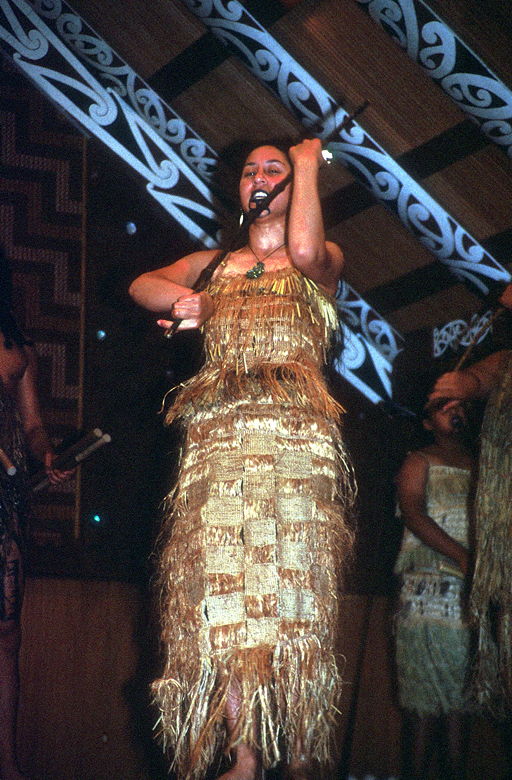
Maori woman performing with long stick
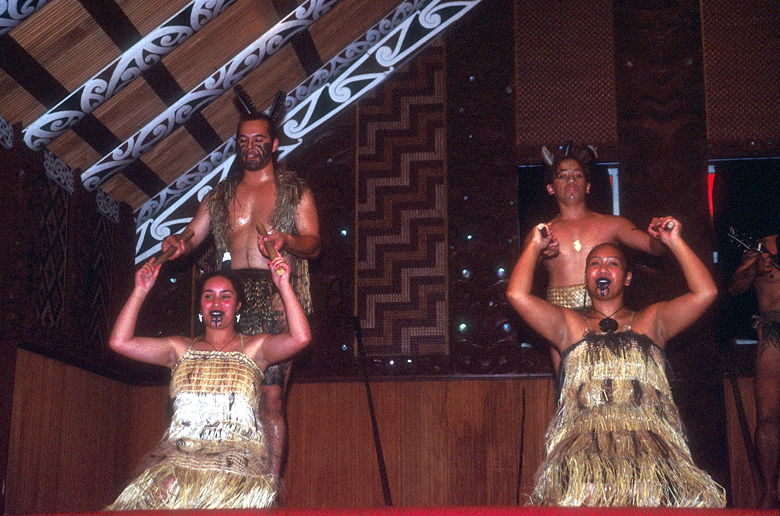
Stick passing
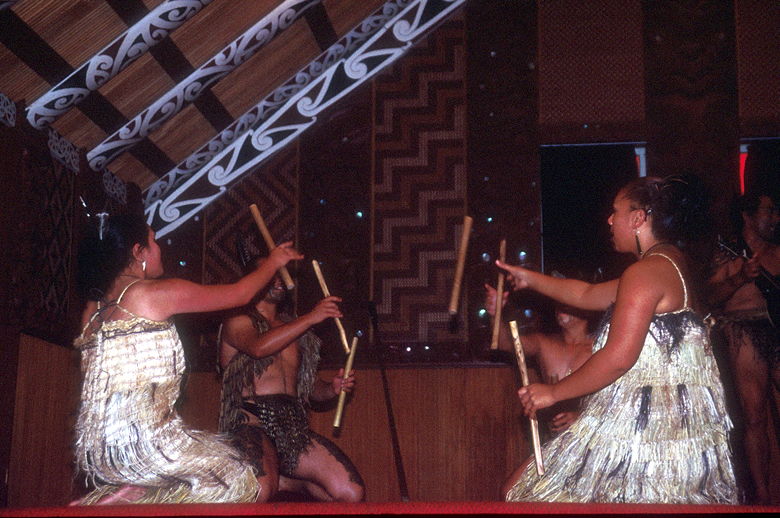
Stick throwing
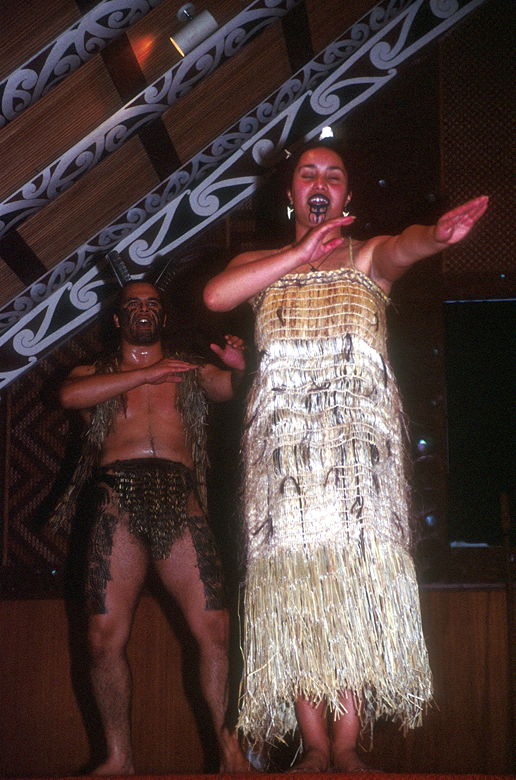
Song and dance during the Maori performance

Hakka
After the show (which included audience participation), we moved to the banquet room for a
hangi feast. There was salad, soups (the seafood chowder and kumera soup were excellent), and meats. And
lots of dessert. The meat was a bit dry -- a bit of a disappointment, but there was enough good stuff to
satisfy us. We sat at a table with 7 others, and we shared stories of our travels in New Zealand so far.
Interestingly, we were the only Americans in the entire group of 50 or 60; the others were mostly Europeans.
They had the people from different countries sing songs related to their countries. Jean and I tried to
hide (well, at least I did), as I had no idea what we could possibly sing. I couldn't think of a song
which is distinctly American but not grossly patriotic.
After looking at the lit Pohutu Geyser (not very exciting), we started the long drive back
to Auckland. We left Rotorua around 9:30pm, not getting into Auckland until about 12:10am.
| 





















